Month 2:22, Week 3:7 (Shibi'i/Sukkot), Year:Day 5946:51 AM
2Exodus 9/40, Omer Count: Sabbath #5/7
Gregorian Calendar: Sunday 15 May 2022
Book of Revelation XVIII
An Introduction to Chapters 4 & 5
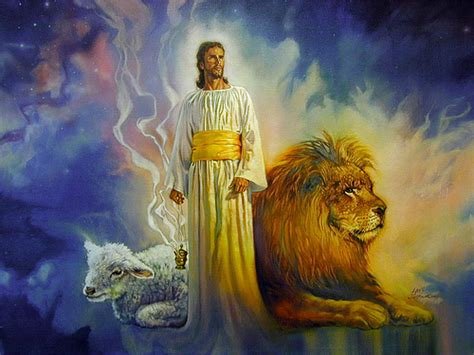
Continued from Part 18
Introduction
Shabbat shalom as we once again dive into the depths of this extraordinary end-book of the Bible, the Book of Revelation.
Review of the Previous Study
Last week we had another review of the first 17 parts and considered the attitudes of the Reformers, Catholics and Eastern Orthodox churches toward the Book of Revelation, as well as liberals and conservatives in general. We also asked, and answered, several questions:
- 1. Should the Millennium be viewed literally or figurately?
- 2. Did John the Apostle or 'another John' write Revelation?
To answer these questions both we simply found out what the earliest talmidim (disciples) believed and it is clear they believed in a literal 1,000 year-long Millennium and were in no doubt that John was the author of Revelation. As to the differences in language styles between Revelation and John's other four writings (the Gospel and three epistles), we marked that down either to different secretaries and translators or John himself translating his own text from Aramaic to his less-than-perfect Greek-as-a-Second Language. Finally, we looked as Johannine word usage to see that it was a little different from the other New Testament writers and agreed, I think, that the best way to interpret the language of Revelation is to use the Gospel of John as a decoding book. We'll let the author interpret it for us.
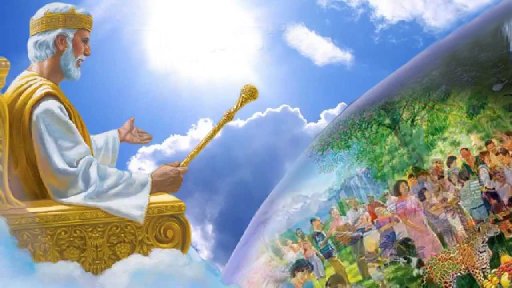 The way we view the millennium affects the way we see other key doctrines
The way we view the millennium affects the way we see other key doctrines
Orientation
Before we plunge into Chapter 4 I think it's important we have the very broadest overview of everything that follows because the Book of Revelation most definitely has a narrative structure. It's not random or higgledy-piggledy. And it's not, as liberals are so fond of accusing, simply different bits and pieces sewn together at different times by different authors at different periods of time to make it look as though prophecy has been fulfilled (since liberals have an essentially materialist worldview and don't believe in revelation and miracles). The Book of Revelation is unitary: it has one author and one continuous story-line which was assembled at the same time. And though there are lots of complex symbols to be decoded, they are readily intelligible once you get your hands on the Johannine code book.
Structure & Overview of the Whole Book of Revelation
Before we look at the next chapter, let's start with a grand overview because the prophetic canvas on which John shares his visions is a broad one. I'm going to try and make this as simple as possible. The Book can be divided into three parts with each part having four sub-sections, or two pairs of sub-sections where the single units of each pair are mirrors or reflections of one another giving contrasts, making a total of 12 sub-sections:
- A. The Present
- Ch.1-3:
- A1. One ascended Master
- A2. 7 Assorted Lampstands
- Ch.4-5:
- A3. Creator & creatures
- A4. Lion & Lamb
- B. The Nearer Future
- Ch.6-16:
- B1. 7 Seals, 7 Trumpets & 7 Bowls
- B2. Devil, Antichrist & False Prophet
- Ch.17-19:
- B3. Babylon - Last Capital
- B4. Armageddon - Last Battle
- C. The Far Future
- Ch.20:
- C1. Millennial Reign
- C2. Judgment Day
- Ch.21-22:
- C3. New Heaven & Earth
- C4. New Jerusalem
Time Perspectives
Remember that the time persepctive here is someone living at the end of the 1st century AD so that for us their 'Present' is very much in the past, their 'Nearer Future' is our present and immediate future, and their 'Far Future' could either be our near future (if we're looking at the start of the Millennium) or our distant future still (if we're looking at the end of the Millennium.
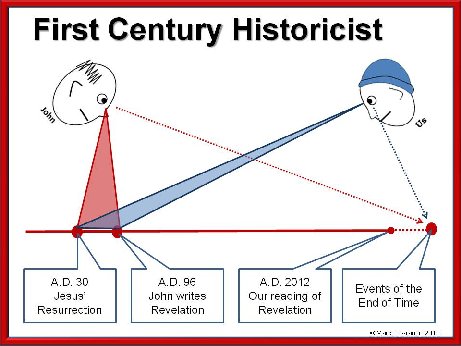 It is important to remember that the present to John is the past to us
It is important to remember that the present to John is the past to us
Hebrew Memorisation Devices
This kind of chiastic structure or arrangement is very typical of Hebraic writings. The topics are arranged this way not simply for the aesthetic pleasure that orderliness like this gives to the mathematical side of our brains wanting to make sense of things but serves as a memorisation device because you must remember the ancients weren't rich, they could each afford to have a copy of a Torah Scroll or (later) a Bible at home, but had to memorise what they heard spoken to them. Because they were trained to remember vast amounts of Scriptural text from a very young age, your average believer back then was a lot more proficient than we are as far as the volume and accuracy of Scriptural knowledge was concerned.
When Bibles Became Affordable
First Guttenberg gave us the printed book and though books were still out of the price range of nearly all believers until the 19th and 20th centuries, we did eventually come to rely on them as our primary source of information and not merely the spoken and memorised word. And then everything went electronic in the 21st century and though we can find vast amounts of information really fast now it has come at a cost: our memory retention is appallingly low and so many suffer from attention deficit disorder - people have such a low attention span. We're also much more visually-orientated in the 21st century which is why you have a diagram to look at on the main screen, and that's not altogether bad, mind you, because the ancients were far more proficient in communicating pictures than in text. In fact, the two were much more integrated. So the primary purpose of arranging the components of Scripture like this was to be an aid to memory.
 Even with the first printing press Bibles were still unaffordable for most
Even with the first printing press Bibles were still unaffordable for most
An Even Simpler Representation
For those of you with problems handling large amounts of data, I'll simplify the table even more. We could say that the Book of Revelation, on the broader scale, is divided into two parts, Present and Future, with the Future broken down into Bad News and Good News:
- Ch.1-3: A. Present (things that must be put right now)
- Ch.4-22: B. Future
- Ch.4-18: B1. Bad News (things will get much worse before they get better)
- Ch.19-22: B2. Good News (things will get much better after they get worse)
The Big Perspective First
So in the simpler scheme, though we're still in Section A - the Present, we are starting the longest part consisting of 18 chapters. As this material is dense with symbolism and meaning, with much of it being unfamiliar to the Western mindset, and often with meanings on many different levels simultaneously, we'll take the material in small chunks. But first, I need to give you an overview of the next two chapters, 4 & 5, which was both the original readers' present as well as ours, because the scene is an unchanging eternal one. So that we don't get over-occupied with detail - and there's plenty of that in what follows - we must always maintain perspective, so you're going to have to multi-task with me somewhat as later we'll be jumping around between levels.
CHAPTERS 4-5: YAHWEH IN HEAVEN
The Heavenly Centre of Praise
For the next five weeks we'll be looking at chapters 4 & 5 which are relatively straightforward, a bit like the first three chapters. Chapter 4 in particular is often quoted to stimulate private praise and worship and has supplied material for many famous hymns and choruses. For me personally it's very inspiring. It's value lies in the fact that it gives a glimpse of that heavenly adoration of which all earthly worship is an echo. Those who have been spiritually regenerated and who know the true spirit of worship will find an instant connection here. And the repentant who have not can ask Yahweh through Yah'shua (Jesus) for that salvation that gives them acess and ask for a connection to the Throne Room for praise. For the first thing a genuinely saved person does is spontaneously praise the Creator! They cannot help themselves.

Paul's Friend Visits Paradise
John is invited to come up to this place to see what Heaven looks like, a privilege very few can claim to have had extended to them. It's also worth reading the parallel, though less dramatic, experience of a brother whom Paul knew in 2 Corinthians, chapter 12, and the first six verses, though we are given little detail:
"I must go on boasting. Although there is nothing to be gained, I will go on to visions and revelations from the Master. I know a man in Messiah who fourteen years ago was caught up to the third heaven. Whether it was in the body or out of the body I do not know - Elohim (God) knows. And I know that this man - whether in the body or apart from the body I do not know, but Elohim (God) knows - was caught up to paradise. He heard inexpressible things, things that man is not permitted to tell. I will boast about a man like that, but I will not boast about myself, except about my weaknesses. Even if I should choose to boast, I would not be a fool, because I would be speaking the truth. But I refrain, so no one will think more of me than is warranted by what I do or say" (2 Cor.12:1-6, NIV).
John in the Very Throne Room of Elohim
I myself have seen Paradise (originally the Persian paradaida meaning an exquisitively beautiful park which the Greeks transcribed into paradeisos) more than once and have seen some pretty amazing things but never have I seen the Throne Room of El Elyon (the Most High God) though I have seen and communed with the Divine Council, one of the most joyful experiences of my life. Albeit it couched in much symbolism to make it comprehensible to His creatures, John describes the place where Yahweh, our Heavenly Father, reigns and from which He rules. The word 'throne' appears no less than 16 times and is an extremely important key word that we will need to examine, as also the word 'sitting' (4:2,9-10; 5:1). If you like, you can view the Throne Room as the 'control or nerve centre' of the Kingdom of Heaven and of the whole Cosmos so we should expect the material in these chapters to be dense with multi-layered symbolism, as indeed it is. I mean, this is 'it' - there is nothing 'higher' in all existence, and that is why the rest of the Book of Revelation starts here. We'll have lots of fun unpacking this and learning more about the angelic realm in the next few weeks too because you will learn about an order of supernatural beings that I am pretty sure most of you have never heard of before.
The Amazing Scene
The scene is, as you would expect, one of breathtaking beauty, defying adequate description. Green rainbows, golden crowns, thunder and lightning, blazing lamps - you can just picture John's eyes darting from one striking feature to another as he gazes in awe and wonder at what lies before him. I remember, when I was usshered into the presence of the Council of Yah's Elohim, how overwhelmed I felt - it felt like coming home, to my real home. I was in a flood of tears. By comparison, even this incredible planet, which has so much beauty in it, felt like a place of desolation. And in trying to describe what he can see of Elohim (God) Himself, John has nothing adequate to compare Him with. How could he possibly? And so he likens Yahweh's appearance with two of the most brilliant gemstones he has ever seen before, jasper (an opaque red or yellow form of quartz) and carnelian (or cornelian, a dull red or reddish-white chalcedony, another kind of quartz). And for those of you live locally here, you'll have seen the beautiful white quartz up the road from this place.
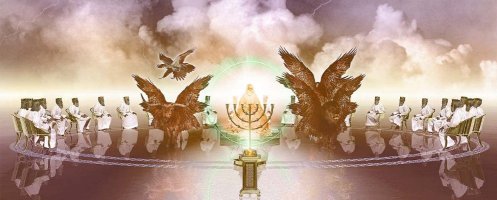 John suddenly found himself in the very throne room of Yahweh...
John suddenly found himself in the very throne room of Yahweh...
The Peacefulness of the Sea of Glass
Yet in spite of the blazing lights there is a peaceful aspect too - a sense of real, abiding shalom - and this is represented as a 'sea of glass, stretching all the way to the horizon. Just imagine that. If you have ever been on board a ship when the sea is becalmed, as I have, with not a ripple on the surface and not a gust of wind, for as far as the eye can see, you'll perhaps understand what this Scripture is telling us. The impact of that stillness - that calmness - on you is breath-taking. And though a becalmed sea was a nightmare to sailing ships of old (as there was no wind they could be stuck for days on end, their water and food supplies ever dwindling), it was nevertheless an amazing sight. The contrast between the vastness of the ocean which before might have been stormy and raging and then that inredible stillness of the waters, like a sheet of glass-like tranquility stretched out to infinity without any land to be seen, makes this scene in the Book of Revelation relatable to me personally, and maybe to one or two of you who have been at sea and experienced this.
 A becalmed sea
A becalmed sea
The Impermanence of the Earthly Sphere
This calm scene which surrounds Yahweh is then contrasted with a different reality - an unpleasant reality - with the profound disturbances of life down here on earth, from chapter 6 onwards. This constrast is clearly deliberate, because without contrasts, we finite human-beings cannot understand what we see and experience. That's why chapters 4 & 5 are so important, reminding us of the ultimate reality, and not the fleeting or impermanent one which we experience here on earth. Yahweh reigns supreme above all the battles between good and evil that take place down both in the lower spiritual dimensions and and down here on earth. Yahweh does not have to struggle as we do - even Satan has to ask permission before he can touch a human being as we learn in the first chapter of Job where we're given a window into the workings of the Divine Council. Yahweh is not even surprised by anything. Nothing catches Him unawares. He knows exactly how to deal with whatever arises in the vast Cosmos He rules over, since that also can only be what He allows. And we too, in our turn, after we have lived down here for a goodly time, are no longer surprised by what life can throw at us. It's all impermanent, it doesn't last indefinitely. Even the Buddhists understand this though they mistakenly think it is all maya or illusion.
The Worth of Worship
Yahweh is Elohim (God), not man, and is worthy of our worship. Did you know that the root of the English word 'worship' is 'worth-ship'? When we worhsip, we tell Him how much worth He is to us, how valuable He is. The Creator of the Universe receives non-stop praise from the creatures He has made because He, the Infinite One, is of infinite worth to them and not because they are compelled. We are next presented with four living ones who resemble creatures 'like' a lion, an ox, a man, and an eagle. Remember these four, for collectively they represent all creatures from the metaphorical 'four corners' of the earth. Now that's not to say there aren't other interpretations of what these four creatures are because there absolutely are, and we will examine these on multiple levels when the time comes.
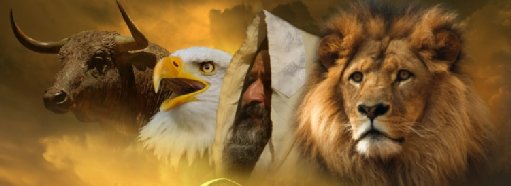 The four living creatures
The four living creatures
The Threefold Nature of Divine Praise
You will notice that their praise is 'threefold' - the word 'qadosh', 'set-apart' or 'holy' is repeated three times when it is directed to Yahweh because He exists in the three aspects of time - past, present and future:
"Day and night they never stop saying:
'Qadosh, qadosh, qadosh (Holy, holy, holy)
is the Yahweh-Elohim Almighty (Yahweh El-Shaddai),
who was, and is, and is to come'"
(Rev.4:8, NIV).
Who are the Twenty-Four Elders?
Great has been the speculation about the 24 elders whom we understand comprise the Council of Heaven or "Council of Yahweh" (Jer.23:18). Who are they? You'll hear all sorts of ideas as to who they are, the most common (and incorrect) one being that they represent the two Covenant peoples of Elohim (God), namely, Israel and the Messianic Community (Church), as if they were two separate things, which they are not. You will be greatly surprised who these beings actually are when we come to minutely dissect the passage in question. Commonly, commentators will point you to the 24 names of the New Jerusalem's gates and foundations (Rev.21:12-14), but don't be too quick to match-make the different 24's that are to be found in the Bible. These 24 have 'crowns' and 'thrones' that represent authority though their authority is only delegated. But more about that when we come to study the number '24' in depth.
The Grand Search for the Worthy One
The interesting thing about chapter 4 is that there is only one action in it - only one thing that's 'done' - and therefore there is only one verb to represent that action, and that word is worship. What we are looking at is something permanent with no time reference whatsoever. This is where everything that follows in chapter 5 begins - it's where the 'action' begins, as it were; and it begins with a search both in heaven and earth for someone 'worthy to break the seals and open the scroll.' Do not miss the sequence between 'worshipping' and 'searching' nor the double location of the searching.
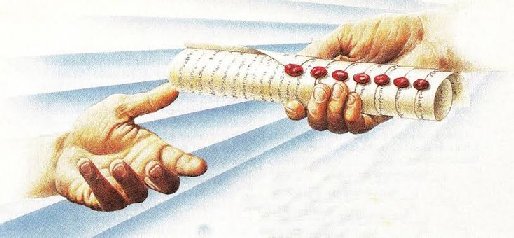
The Double Location of the Mortal Messiah
Indeed, I am hoping you will already have made the association of this interesting 'search' with what Yah'shua (Jesus) said about Himself to Nicodemus when the latter came for a private interview by night and was informed that the Son was simultaneously both on the earth and in heaven!
"And no man hath ascended up to heaven, but He that came down from heaven, even the Son of man which is in heaven" (John 3:13, KJV; cp. CLNT)
or as the Aramaic correctly renders this passage too:
"And no man has ascended into heaven but He who descended from heaven, the Son of Man, who is in heaven" (John 3:13, HRV; cp. AENT).
When Dishonest Translators Mutilate the Text
This is a hugely important truth that conceales a multi-layered mystery to which we shall be returning to study in detail. Most modern translations drop the final "who is in heaven" because some manuscripts do not include it. Scholarly translations (like the NRSV) include it in a footnote with some (like the NEB) twisting the meaning by adding words that aren't there [1] and others (like William Barclay's paraphrase) giving the impression that John made a mistake but, rather than cross out the error, adds a self-correction afterwards! [2]. Do you see the unwarranted liberty that some translators take and in effect turning their translation into a personal commentary? So be careful of translators! Don't give them carte blanche, check them out thoroughly. But for now remember the 'Nicodemus incident' and in particular John 3:13 but be sure to first read it in the King James Version (KJV) and then compare it with the way other versions translate this passage for you will be surprised and not a little perplexed and then (as I was) angry. You cannot mutilate Scripture to suit your personal beliefs as the Masoretes did (for example). In this case, the Byzantine text has the correct rendition because the Aramaic confirms it.
Serious Study Needed
Now you must understand that I am only giving you a very thin overview here - I don't want to dig deep just yet, but rather just throw some tantalising clues in your direction so you can search these things out for yourself. You will only profit from these studies if you do some serious searching of your own. The soil of your own mind is most important else the seed I sow will not sprout and survive, let alone be properly checked out.
The Importance of Countdowns
A great ado is made about the 'scroll' mentioned in Revelation 5:1-9 and it soon becomes significant in the light of events. On that scroll is written the entire program which will bring an to end the æon or age of earth's history which we, even now, have the privilege of participating in. Once the seals are broken the countdown begins...and no doubt some of you will have wondered about the various 'countdowns' to Penultimate Judgment we had a while back which so many pooh-poohed. Yet as Revelation makes clear there are multiple countdowns and we have witnessed the shadow countdowns in our own time. Remember, this is the dress rehearsal of the last countdowns.
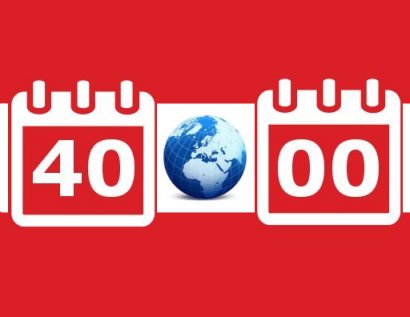 The Book of Revelation contains numerous countdowns
The Book of Revelation contains numerous countdowns
A Decisive Termination of the Kingdoms of the World
Until the seals are opened and the countdowns begin...just as we're making our annual countdown to Shavu'ot (Weeks, Ekatost, 'Pentecost') in the Omer Count (that practically everyone who does the count gets wrong, a reason so many false prophecies are made and way too early), the world must continue in its present state. The 'present evil æon or age' must be first closed before the "æon or age to come" (Mt.12:32; Mk.10:30; Lk.18:30) can open. There must be a decisive termination of the "kingdoms of the world" (Mt.4:8, Lk.4:5; cp. Rev.11:15) if the "Kingdom of Elohim (God)" (Mt.12:28) is to be universally established on the earth (Rev.11:15). And that is why John "wept and wept" in frustration and grief when no one was found "worthy" (deserving of worship) to set this all in motion (Rev.5:4).
The Lion and the Lamb
Now you may be wondering why on earth this was a problem. Yahweh Himself had released many judgments on the earth throughout history. Why not, then, release the final ones Himself? And there are only two possible answers to that question: either:
- 1. He does not choose to do so; or
- 2. He does not feel He is qualified to do so!
Now before you dismiss the second option as either bizarre or even blasphemous, consider what is said about the one Person who is found to be 'worthy'. Who is this Person who is described as both a "Lion" (Rev.5:5) and a "Lamb" (Rev.5:6,8,12-13)? This may seem to some to be a great contrast - the towering, ferocious lion and the tiny, harmless lamb - and yet difference is not as much as you might suppose. The Lamb is male and fully mature, as was every lamb used in the sacrificial system of the Old Covenant (it was "one year old" to be precise - Ex.12:5). It wasn't a newborn. Properly, we should be referring to this Lamb as the Ram (e.g. Gen.15:9), which is depicted symbolically as having "seven horns" (signifying perfect power) as well as "seven eyes" (signifying perfect oversight) (Rev.5:6). We, as Jacob or Israel, have only '6 horns' and '6 eyes', metaphorically-speaking. Yet this Lamb or Ram has been 'slain' as a sacrifice. So the 'Lamb' or 'Ram' is not so weak as you might at first suppose.
Emblems of the Messiah and the Israelite Nations
The Lion is 'king of the jungle', but here He is of the tribe of Judah and rooted in the Davidic Dynasty. Many of the Israelite nations use the lion as their national emblem - Great Britain, the Netherlands, Belgium, Luxemburg, Norway, Sweden, Denmark, Finland, Estonia, Normandy, Bohemia and Bulgaria to name the main ones, because in most cases Judah is there in the mix (it is particularly strong in Northern Ireland). The eagle is the next most common emblem as found in Germany (plus USA), Austria, Russia, Poland, Romania, Moldova, Serbia, Monte Negro, Albania, and others, which are two of the creatures John saw worshipping Yahweh. The ox is less common and is found in such cities as Oxford, with the man-figure very rare, though you may not know Prussia used both the eagle and a man in its heraldry. But I digress. So we have a unique combination of the Sovereign Master and the Sacrificial Lamb, which exactly corresponds to the coming king and suffering servant prophecies made by Isaiah (Is.9-11; 42-53).
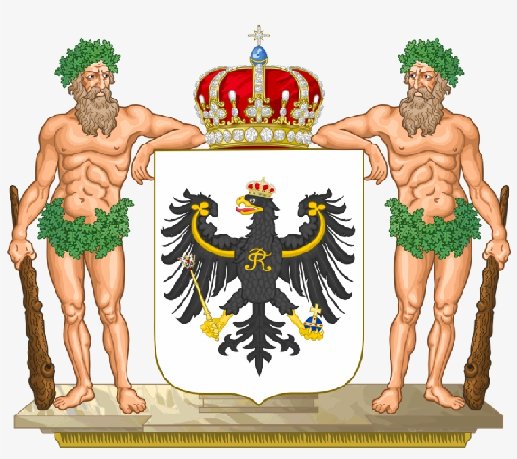 Coat of arms of Prussia showing both the eagle and the man
Coat of arms of Prussia showing both the eagle and the man
The End - the Termination or the Goal?
But it is not just what Yah'shua (Jesus) is but what He has done, that qualifies Him to release the troubles that will bring the world to an end, remembering that the word 'end' can mean two things in English:
- 1. Termination; or
- 2. Consummation/Goal.
Well, in exactly the same way that "Christ is the end (goal) of the Torah (Law)" (Rom.10:4, NIV), so 'end of the world' here does not mean its extinction, but rather its CONSUMMATION or END-GOAL, which is a big difference both for the Torah (Law) and the world. This correct understanding at once eliminates a HUGE error in orthodox Christianity which claims the Torah (Law) has been 'done away with', 'ended' or 'nailed to the cross' [3] and that the physical world will come to a permanent end and we will all live finally and eternally as disembodied spirits in a spirit-world called 'heaven', both doctrines of which are FALSE: the Torah is the lifestyle of the saved, and the world, though indeed "the elements will melt in the heat" (2 Peter 3:12, NIV) one day, will remain to be glorified and become the home of the physically resurrected qodeshim (saints, set-apart ones) who are the Bride for the æons upon the æons, from one age to the next, le-olam-va-ed, forever and ever.
Preparation for Priestly Duties of the Melchizedek Remnant
Yah'shua (Jesus) has prepared, and is preparing, a people to take over the governments of the world. He has purchased them, at the price of His own blood, out of every ethnic group in the human race and grafted them into Messianic Israel (Rom.11). He has trained them, and will train them, in Royal Melchizedek priestly duties in Yahweh's service and thus prepare them for the responsibility of reigning on the earth (Rev.5:10), a theme that is fully developped in chapter 20, verses 4-6, which reads:
"I saw thrones on which were seated those who had been given authority to judge. And I saw the souls of those who had been beheaded because of their testimony for Yah'shua (Jesus) and because of the Davar Elohim (Word of God). They had not worshiped the beast or his image and had not received his mark on their foreheads or their hands. They came to life and reigned with Christ a thousand years. (The rest of the dead did not come to life until the thousand years were ended.) This is the first resurrection. Blessed and qodesh (holy, set-apart) are those who have part in the first resurrection. The second death has no power over them, but they will be cohenim (priests) of Elohim (God) and of Christ and will reign with Him for a thousand years" (Rev.20:4-6, NIV).
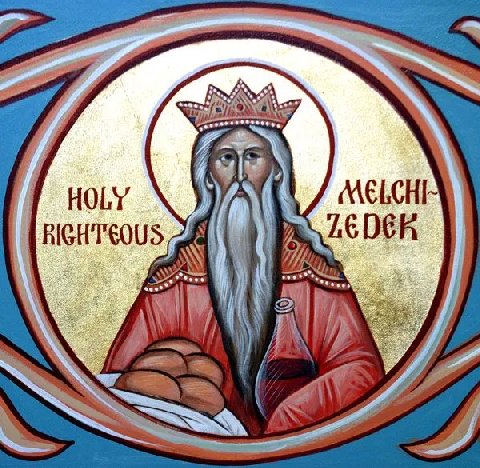
The New Government Being Readied
Only someone who has done all this is able to begin the series of disasters that will bring all other régimes down. To destroy a bad system without having a good one ready to replace it can only lead to anarchy. And He Himself is a worthy sovereign over the government He has prepared, and is preparing, precisely because He was willing to give His all to make it possible. It was because He became "obedient to death - even to death on a cross" that 'Elohim (God) the Father has exalted Him to the highest place' (Phil.2:8-9).
To Him Be Given the Glory
No wonder thousands of malakim (angels) agree, in musical acclamation, that it is only right to give Yah'shua (Jesus) the Son "power, wealth, wisdom, strength, honour, glory and praise" (Rev.5:12). Then all the creatures in the universe join the choir's anthem, though with one significant addition. The "power, wealth, wisdom, strength, honour, glory and praise" should be shared between the One sitting on the throne and the One standing in the centre in front of Him, the Father and the Son together, for it was a joint effort. They were both involved. They both suffered to make it possible, though in very different ways.
The Divine Messiah Established
Nothing more clearly reveals the divinity of our Master Yah'shua the Messiah (Jesus Christ) as the offering of unqualified praise and worship to both Him and Yahweh together.
Conclusion
I hope you have found this summary of the next two chapters both helpful and encouraging, and that you will be inspired to dive into the Book of Revelation with ever more enthusiasm and relish. Next week we will begin a detailed analysis of the first half of chapter 4, verses 1 to 6a. So until then, Yahweh bless you and keep you. Amen.
Continued in Part 20
Endnotes
[1] "No one ever went up to heaven except the one who came down from heaven, the Son of Man, who[se home] is in heaven (sic.)" (Jn.3:13, NEB)
[2] "There is only one person who has gone up to heaven, and he is the person who came down from heaven, I mean, the Son of Man who comes down from heaven (sic.)" (Jn.3:13, Barclay)
[3] It's the penatty for breaking the Torah that is 'nailed to the cross', not the Torah itself - see the New Covenant Torah website
Acknowledgements
[1] David Pawson, Unlocking the Bible: A Unique Overview of the Whole Bible (Collins, London: 2007)
[2] E.W.Bullinger*, Number in Scripture (Kregel Publications, Grand Rapids, Michigan: 1967)
[3] E.W.Bullinger*, Commentary on Revelation (Kregel Classics, Grand Rapids, Michihan: 1984)
[4] E.W.Bullinger*, The Companion Bible being the Authorized Verion of 1611 with Structures & Critical Explanatory Notes (Samuel Bagster & Sons Ltd., London: 1974), pp.1883-1914
*E.W.Bullinger was a brilliant Anglican clergyman and scholar whose works merit careful study by serious students of the Bible. He was, however, seriously in error in at least three main areas, namely, (1) he believed the 'Church' has been raptured before the Book of Revelation opens, (2) he believed that the 7 churches in Revelation 2-3 are 7, literal Jewish churches or assemblies yet to come, and (3) he believed in a pre-tribulation, pre-millennial rapture.
Comments from Readers
[1] "I would like to thank you for your faithfulness in delivering such powerful and well delivered teachings. I am learning so much and feel blessed I was miraculously led to your [video] channel. It simply popped up in my feed over 6 months ago and I've watched all your teaching on Rumble. Your teachings on Revelation have opened my spiritual eyes more than words could ever convery - truly a blessing!...Blessings to you and thank you again for sharing your anointed teachings on Rumble so we can grow in our understanding and relationship with Yahweh" (KB, USA, 31 May 2022)
 Click the image for the whole Series
Click the image for the whole Series

 V351
V351
|


